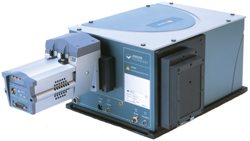Mar 3 2010
Using a novel hybrid sensor system, which relies on Shamrock spectrometers and high performance intensified CCD detectors supplied by Andor Technology (Andor), Spanish scientists have been able to use both Raman and Laser-Induced Breakdown Spectroscopy (LIBS) simultaneously for the instant, remote standoff analysis of explosive materials.
 Mobile hybrid sensor system
Mobile hybrid sensor system
Since the new system allows complementary molecular identification and molecular abundance information to be gathered from two different sensing techniques, it represents a far more powerful analytical tool for the standoff detection of explosives present in trace quantities.
One completely field-tested, mobile hybrid sensor system based on this hyphenated spectroscopy approach, could potentially be safely used in the standoff detection of explosives residues left, for example, by human fingerprints on surfaces such as car door handles from distances up to 50 metres . It could also be used to check for explosives hidden within parked vehicles by taking measurements through windscreens and windows.
The new hybrid detection system was developed at the University of Malaga, Spain, by a team led by Professor José Javier Laserna. By integrating two Andor Shamrock SR303i spectrometers and iStar intensified CCDs, a Cassegrain telescope and a frequency doubled 532 nm Nd:YAG nanosecond laser pulses, his team was able to make simultaneousacquisitions from the same sample of Raman - Molecular information - and LIBS spectra - Multi-elemental information - for 4-mononitrotoluene (MNT), 2,6-dinitrotoluene (DNT), 2,4,6-trinitrotoluene (TNT), cyclotrimethylenetrinitramine (RDX), C4 and H15 (both plastic explosives containing 90% and 75% of RDX by weight, respectively), and Goma2-ECO (Spanish denominated dynamite class high explosive).
According to Professor Laserna, "The Andor iStar iCCD detectors played a vital role in allowing us to develop this new mobile standoff detection system since their sensitivity allowed us to work with exceedingly low light levels. Furthermore, their refresh rates meant we could analyze spectral information at rates in excess of 10Hz and, therefore, perform simultaneous Raman and LIBS spectroscopy in real time. We are now working on the integration of chemometric tools and data fusion strategies to further enhance the systematic analysis capabilities of this hyphenated mobile sensing system."